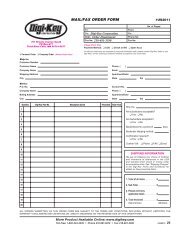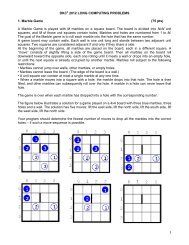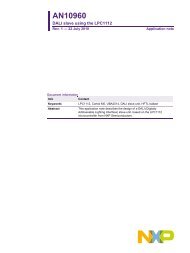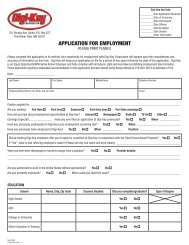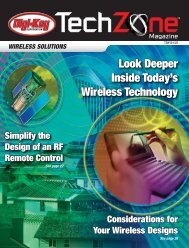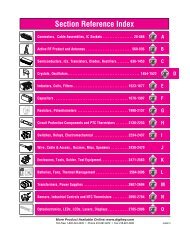Microcontroller Solutions TechZone Magazine, April 2011 - Digikey
Microcontroller Solutions TechZone Magazine, April 2011 - Digikey
Microcontroller Solutions TechZone Magazine, April 2011 - Digikey
You also want an ePaper? Increase the reach of your titles
YUMPU automatically turns print PDFs into web optimized ePapers that Google loves.
The result is usually a limp-home mode in which a node will attempt<br />
to run itself without information from the rest of the network. In some<br />
cases, a punitive limp-home mode is entered that forces the user to<br />
perform repairs.<br />
A good example is if the transmission fails and proper shifting<br />
becomes impossible. In this case, the module will go into limp-home<br />
mode and the transmission might be put into one gear, such as<br />
second, to allow the vehicle to still be driven.<br />
This can be for safety reasons or to prevent further damage to the<br />
power train.<br />
Heart-beats and Address Claiming: The other side to a time-out<br />
is a heartbeat. Periodic messages can be sent out to determine that<br />
all nodes are on the bus and active. CANopen uses such heartbeats.<br />
J1939 has a software mechanism in which each node can declare<br />
itself to be on the bus and be recognized by the other nodes. This<br />
is called “Address Claiming” and occurs during the system startup.<br />
These mechanisms are provided by your software.<br />
Sequence of transmitting data on the CAN bus:<br />
1. Any node(s), seeing the bus idle for the required minimum time,<br />
can start sending a CAN frame.<br />
2. All other nodes start receiving it except those also starting to<br />
transmit a message. (They all start at the same time.)<br />
3. If any other node starts transmitting, the priority process starts.<br />
The node with the highest priority continues on and those with a<br />
lesser priority stop sending, immediately turn into a receiver and<br />
receive the higher priority message.<br />
4. At this point, only one node is transmitting a message and no<br />
other nodes will start at this time.<br />
5. When the transmitting node has completed sending its message,<br />
it waits one bit time for the 1-bit ACK fi eld to be pulled to a logic<br />
0 by any other node (or usually all of them) to signify the frame<br />
was received without errors.<br />
6. If this happens, the transmitting node assumes the message<br />
reached its recipient, sends the end-of-frame bits and goes<br />
into receive mode or starts to send its next message if it has<br />
one. The receiving nodes pass the received message to their<br />
host processors for processing unless the acceptance fi ltering<br />
prevents this action.<br />
7. At this time, any node can start sending any messages or the bus<br />
goes into the idle state. Go to 1.<br />
8. If this does not happen (ACK bit not set), then the transmitting<br />
node retransmits the message at the earliest time allowed. If<br />
the ACK bit is never set, the transmitting node will send this<br />
message forever.<br />
Transmitting notes:<br />
• How does a node know when it should transmit a message<br />
Create the CAN frame you want to send by loading up the IDE,<br />
ID, DLC. Any data byte registers in the CAN controller and then,<br />
in most controllers, you set a bit that triggers sending the frame<br />
as soon as legally possible. After this, the controller takes care<br />
of sending all frame bits. Until the controller signals otherwise<br />
to the processor, you can assume the message was sent.<br />
• What if there is an error All nodes, including the transmitting<br />
node, monitor the bus for any errors. If an error condition is<br />
detected, a node (or nodes) signify to the other nodes there is an<br />
error by holding the bus at logical 0 for at least 6 bus cycles. At<br />
this point, all nodes take appropriate action. The message being<br />
sent (and now aborted) will be resent but only a certain number<br />
of times.<br />
• What if no node wants or uses the message Nothing.<br />
The ACK bit only says that the CAN frame was transmitted<br />
without errors and at least one node saw this frame error free.<br />
Remember the transmitting frame cannot ACK itself. CAN does<br />
not provide any acknowledgment mechanism that a frame was<br />
used or not received by its intended recipient. If needed, you will<br />
have to provide this in your software as many systems do.<br />
TIP: In a periodic system, if a node misses a message, it does<br />
not matter much as another copy will be along shortly.<br />
Sequence of receiving data from the CAN bus:<br />
1. All nodes except those currently transmitting frames are in<br />
listening mode.<br />
2. A CAN frame is sent using the procedure as described previously<br />
in “Sequence of Transmitting data on the CAN Bus.”<br />
3. This frame is received by all listening nodes. If deemed to be<br />
a valid CAN message with no errors, the ACK bit is set. In CAN<br />
terminology, the bus is set to the “dominant” state as opposed to<br />
the “recessive” state.<br />
4. The frame is sent through the controller’s acceptance fi lter<br />
mechanism. If this frame is rejected, it is discarded. If accepted,<br />
it is sent to the controller FIFO memory. If the FIFO is full, the<br />
oldest frame is lost.<br />
5. The host processor is alerted when a valid frame is ready to be<br />
read from the FIFO. This is done either by an interrupt or a bit<br />
set in a controller register. This frame must be read as soon as<br />
possible.<br />
6. The host processor decides what to do with this message as<br />
determined by your software.<br />
Receiving notes:<br />
• <br />
is available. Polling is where the host processor “polls” or<br />
continuously tests the bit mentioned in sequence 5. Polling runs<br />
the risk of losing or “dropping” a frame but is sometimes easier to<br />
implement and debug. Interrupts cause the processor to jump to<br />
an interrupt handler in which the frame is read from the controller.<br />
Using interrupts is the recommended method.<br />
• What happens if a message is “dropped” This can cause<br />
some problems as CAN itself does not have a mechanism<br />
for acknowledging a CAN frame. If desired, this must be<br />
added to your software. In the case of Periodic Messages, it<br />
doesn’t normally matter as a replacement message will be<br />
along shortly.<br />
52



